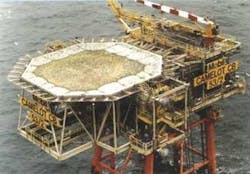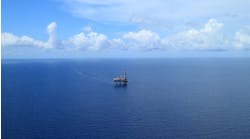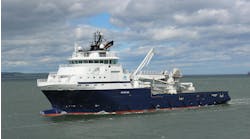Untried umbilical planned for Norne
Statoil's recent dry well on the Blåmeis prospect will have little impact on its Norne area exploration program. The well, drilled by the semi Stena Don, was targeting a potentially large oil-bearing structure in Jurassic sandstone 15 km east of the Norne field. Production from Norne, in the Norwegian Sea, is due to come off plateau this year, so further reserves are needed to maintain the field's FPSO at full throttle. The partners have already approved plans for further exploration drilling on the Lerke and Graaspett prospects, southwest of Norne, in the first half of this year.
Any oil discovered would ideally be drawn in through the FPSO, but heavy crude may warrant adding a second dedicated floater. Crude from two untapped satellites farther north, Falk and Svale, is heavier than Norne's, and would therefore lower the quality of that vessel's output.
Last year, Statoil initiated a three-year Norne tieback technology study, with special relevance to another satellite, Staer. The focus is on the so-far untried integrated production umbilical (IPU), conceived by a consortium including Statoil and Kværner Oilfield Products. The IPU would have a large-diameter production flowline at its core, with an insulating layer that would also house control lines and a power cable. The latter might be used to power a subsea water injection pump that would provide reservoir pressure support. This could eliminate the need for separate water injector lines, in turn limiting the number of risers needed to accommodate extra production from the satellites. In the event of a shutdown, the IPU could also heat the production flowline to prevent blockages caused by hydrate formation.
For the concept to work, the partners need to identify a type of steel that could cope with an 80° C wellstream, without the need for sacrificial anodes. External/internal stresses are another concern. The solution may be to install the IPU on the seabed only, retaining conventional flexible risers for the topsides connection.
Offshore power link 'uneconomic'
Powering Norwegian platforms with electricity from the shore would be too expensive, with insufficient environmental benefits, according to a study by the Norwegian Petroleum Directorate and the Norwegian Water Resources and Energy Administration covering Oseberg, the Southern North Sea, and the Norwegian Sea. Costs for installing subsea power cables, converter stations, platform modifications, and other measures were put at $1.5 billion, with resulting opex savings of a mere $43.6 million. Taking electricity offshore would also entail adding new capacity to the country's gas-fired plants onshore or importing extra energy from coal-fired sources. This would raise costs further, due to the need for CO2 capture measures, and would likely also increase overall emissions.
The Camelot CB platform, prior to its recent removal by the crane barge Thialf.
Partly in light of this report, BP recently recommended shelving its own plan to power its Norwegian North Sea fields from the shore. Another factor was supplier estimates of $548 million for the work involved, against BP's own prediction of $411 million.
Removal options studied
Heerema's heavy lift barge Thialf recently extracted the redundant Camelot CB platform from the UK southern North Sea. It was taken to a specialist dismantling site in Teesside, northeast England. Operator ExxonMobil expected 99% to be re-used, with re-sale potential for large items such as the helideck, cranes and generators. Mobil installed the platform in 1992, and production ceased in 1998.
Kerr-McGee had sought a new home for its decommissioned Hutton field TLP. In the event, the topsides were acquired for re-use on a platform in the Russian sector of the Barents Sea. However, the fate of the remainder of the TLP has yet to be determined. Elsewhere, the UK and Norwegian governments are holding talks with the Ospar commission concerning the bases of three deactivated concrete platforms on the Frigg field. The Frigg partners want the bases left in situ, claiming this is the best option in terms of human, technical, and environmental risk.
Muted approval for royalty removal
Britain's Chancellor, Gordon Brown, has finally implemented abolition of 12.5% royalty on old producing UK North Sea fields. The much-heralded move was designed to appease UK operators outraged by his unexpected 10% supplement on corporation tax last April.
Reaction has been mixed. The UK Offshore Operators Association said the change would encourage investment in Britain's 30 oldest gas fields (royalty applied to pre-1982 developments), thereby realizing an extra 440 MMboe. This would partly offset the estimated shortfall of 650,000 boe/d predicted by Ukooa, against the government's stated vision of 3 MMboe through the end of this decade.
These 30 fields account for 20% of UK continental shelf capital outlay, estimated at £3.5 billion in 2001. But Ukooa pointed out that this change alone would not heal the scars caused by last April's punitive measure, which it claims will increase the industry's tax burden by £8 billion. Corporation tax is hitting new field developments in particular.
Analysts Wood Mackenzie calculated that the royalty rescission would add £790 million to the remaining value of UK North Sea assets, equivalent to a 2.2% increase. It valued netbacks to the supermajors – the shelf's main investors – at £224 million for BP, £123 million for ExxonMobil, and £110 million for Shell. Some smaller, mature field specialists like Talisman should also benefit. Further, revitalizing production from older fields would temper the damage caused by the downturn in North Sea exploration drilling, with 45% fewer wells drilled in the sector last year compared to 2001. On the other hand, royalty payments had been deductible anyway against petroleum revenue and corporation taxes.
Seven Heads sanction
Ireland's government has awarded Ramco Energy a petroleum lease for its Seven Heads gas field development in the Celtic Sea. Concurrently, the operator concluded a gas sales agreement with UK utility Innogy to buy its entire share of production (86.5%) from the field, due onstream by year-end. These formalities in turn allowed Ramco to clinch £60 million of financing for the project from the Bank of Scotland. The Seven Head partners now aim to start development in April, re-completing one well and drilling five further producers, all of which will feed through to Marathon's Kinsale Head facilities off southern Ireland through a subsea manifold. Production, expected to peak at 80 MMcf/d, will meet 10% of the nation's gas needs.
Off northwest Ireland, Shell is thought to have made a discovery with its well on the 1,480-m water depth Dooish prospect, completed in October by the semi Jack Bates. The well is currently tight.
NAM, Shell's upstream joint venture in The Netherlands, is also believed to have notched up two gas finds, one in the little-developed G quadrant close to German waters, and another in the prolific K/15 license. Gas was also the likely outcome of Mærsk's recent appraisal well in the Danish sector, gauging the southern extent of a Cretaceous/Tertiary reservoir shared by the Igor and Sif discoveries. This may hasten development of both fields through wellhead platforms.




